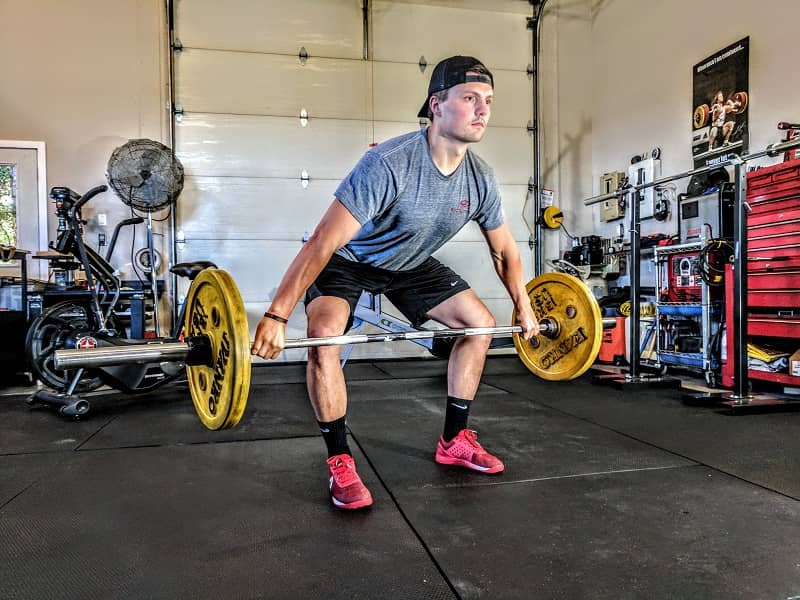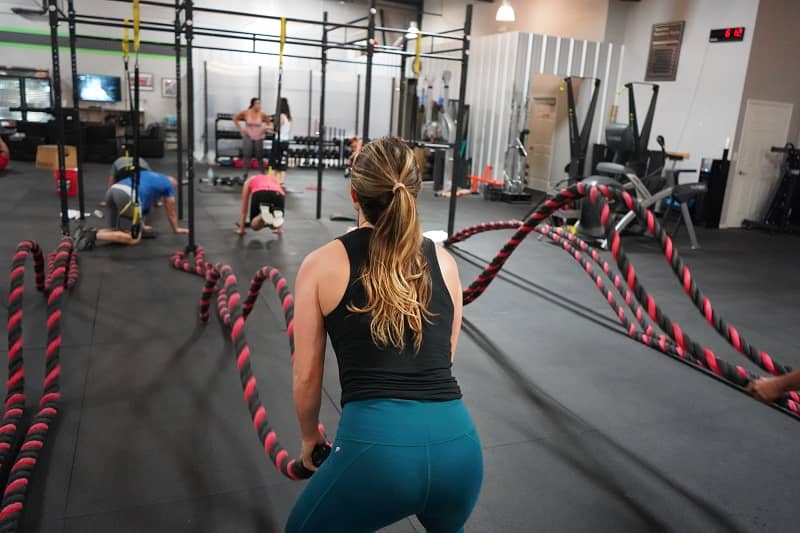Cardio vs weight training for belly fat—what’s best?
If this question popped in your head, you aren’t the only one. Almost everyone planning to hit the gym to shred their bulging out belly fat thinks about this tricky question at times.
Undoubtedly, cardio and weight training together are highly preferred in the fitness world. They are the most popular workout programs.
Still, it’s hard to assess what will work for you.
This blog focuses on various aspects of cardio vs weight training for fat loss. Going through it will help you come up with the best decision for your goals.
Cardio vs Weight Training for Belly Fat | Which One Should I Do?

Cardio or weight training, both workouts have their own benefits and specific working mechanisms.
Let’s see what studies state about these weight loss programs and how you can choose between cardio vs weight training for belly fat!
Cardio Burns More Calories Per Session
Various researchers have figured out analyzing the calories burnt during a specific workout.
Taking the study into account, you can use your body weight to calculate the possible calories you can burn by performing different workouts. This includes cardio and weight training as well.
For most workouts, the more your weight is, the more calories you burn.
If your weight is 160 pounds (73kg), the calorie-burning will be 250 calories per 30 minutes of jogging at an average speed. With a faster pace of up to 6 miles per hour, you would shred off 365 calories in 30 minutes. Instead, weight training at the same time would burn only around 130–220 calories.
In other words, the calorie-burning rate per session is higher with cardio than weight training for the same time.
Weight Training Helps You Burn More Calories Every Day
Weight training necessarily doesn’t burn more calories in a single session. It has other perks and benefits that compensate. Knowing how does lifting weights burn belly fat can clear your doubts.
In fact, it is more effective when it comes to muscle building. The more muscles you’ve, the more calories you are going to burn, including fat.
This is why muscle building is the key to promote your resting metabolism. This determines the number of calories you burn at rest.
One study investigated the resting metabolism of the subject for 24 weeks of weight training. At last, for male participants, the increased resting metabolism was 9%.
However, the increase was only around 4% in females.
This does sound good, but let’s understand it in terms of calories. For men, the calories burnt due to resting metabolism is 14 calories per day, whereas, in women, it was only 50 calories.
Evidently, muscle building with weight training won’t get your metabolism to a high.
However, the fat-burning would significantly improve. Also, we can’t ignore the other calorie-burning effects of weight training.
More research suggests post-workout calorie burn rate is higher after weight training than cardio.
Clearly, the fat-burning effect of the training program doesn’t remain limited to workouts only. In fact, even hours after getting out of the gym you would be burning a significant amount of fat.
So, is cardio or weights better for losing belly fat? It’s a tricky question to answer. Well, the above explanation shares a few pieces of evidence in favor of each.
But let’s have a look at the benefits of both the workout programs to decide between cardio vs weight training for belly fat.
Benefits of Cardio for Fat Loss

Cardio is one of the most popular workout programs.
Not only it helps your physical wellness but also improves your cardiac health. That’s where it has derived its name from.
#1. Better Heart Health
Running effectively improves your heart health.
Remember the first time you ran; you were nearly to pass out. Your heartbeat was so fast as if it would come out of your chest. You were breathing heavily.
However, things change, and the third and fourth time, the situation is very different.
Your heart works accordingly to pump enough oxygen efficiently when you are working out.
Luckily, those who aren’t a big fan of running can go for other cardio workouts, which improves heart health equally. This can be cycling, jogging, walking, hiking, or swimming.
#2. Suppresses Appetite
Who doesn’t want to snack on tasty munchies? However, a cardio exercise may help in regulating your appetite.
A study on people performing high-intensity cardio (cycling, moderate-pace running, or a HIIT) had 11% less hunger in the next 24 hours.
Working out at such a pace makes your body supply enough blood to prevent overheating. The blood diverted from your stomach to your whole body puts a stop to your appetite.
#3. Supports Fat Loss
Cardio workout burns more calories than weight training for its continuous intensity. This is why performing cardio for fat loss helps you get slimmer quickly.
Still, the type of cardio you select determines the final results:
- LISS (Low-Intensity Steady-State Cardio) is best for those with huge weight loss goals. It is good for beginners wanting to shred body fat.
- HIIT (High-Intensity Interval Training) is best for retaining existing muscle. Also, it is good for promoting fat loss and fat burning quickly.
#4. Budget-Friendly
What makes cardio different and unique from other workouts is its accessibility and budget-friendly nature.
First, it doesn’t require you to buy an expensive fitness center or gym subscription. You can run, walk, jog, swim, or cycle. These workouts are entirely free.
#5. Improves Brain Power
With age, the human brain begins to lose cells and tissues. The process initiates as we hit the benchmark of 30 leaving a significant impact on our cognitive performance.
Nonetheless, some studies suggest regularly performing cardio may help in reducing brain tissue loss every time.
Moreover, another study showed people how regularly performing the workout had an amazing boost in brain tissue.
#6. Helps Maintain Healthy Blood Pressure Levels
If high blood pressure is a constant issue, cardio workouts may help lower them.
A study showed data for the effectiveness of endurance exercise in reducing blood pressure levels in sedentary adults.
The workouts investigated were steady-state cardio including cycling, jogging, walking, and swimming.
#7. Protects Your Immune System
Having a strong immune system is important for overall health. Studies show how regularly performing cardio can boost your immunity.
Research has found regular and moderate exercise has promising effects on the immune system by growing “immunoglobulins”, which are immune-system protecting molecules produced from your white blood cells.
So, what to choose: Cardio or weights first for weight loss?
Here are the benefits of weight lifting exercises for belly fat for clearer insights on this.
Benefits of Weight Training for Fat Loss

Now, it’s time we understand the different advantages of weight training on overall health.
The leading weight loss program isn’t only beneficial for fat loss, but other body processes as well.
Let’s have a look here!
#1. Muscle Building
Weight lifting helps in muscle building. It isn’t a surprising fact. Training with weights increases resistance during the workout.
Eventually, this results in greater muscle tear and broken tissues.
Thus, the response of the body toward cleaning up the mess and repairing muscle tissues works at a tremendous rate.
Hence, you have bigger muscles and huge strength in a short time. This process is known as ‘hypertrophy’.
#2. Activates Metabolism for Fat Loss
Weight training activates your metabolism leading to quick fat loss. The science is simple.
Weight training increases lean muscle, the more lean muscle the higher metabolism, the higher metabolism, the more calories burned.
Cardio workouts burn more calories in a workout session, whereas weight training keeps you in fat-burning mode constantly.
This leads to larger and sustained calorie burn throughout the day.
#3. Protects and Improves Bone Health
Overall wellness depends only on good bone health. In fact, regularly performing weight training may increase your bone health.
Specifically, this is good for people having a sitting job. It is necessary to work out to make bones and muscles stronger.
#4. Releases Stress
Lifting weights may lighten your stress levels. Also, it restricts the stress hormone to improve focus and concentration. Also, it may promote cognitive activity.
Fortunately, the International Journal of Sports Medicine, in a study, found surprising facts. It observed a shocking reduction in cortisol levels of participants performing weight training for two weeks.
#5. Aids Sleep
Weight training for fat loss in females and males works like magic. On top of that, the workout program helps in relieving stress.
Recent studies found it effective in elevating sleep quality.
According to a study in Clinics in Sports Medicine, weight training exhausts your muscle, whereas the drop in cortisol level promotes good sleep.
Thus, weight training has various benefits apart from weight loss.
Undoubtedly, it emerges as the top option in the fitness world for effective fat loss goals. However, HIIT may help in your weight loss goals as well.
HIIT and Traditional Cardio May Help in Weight Loss
Cardio and weight training together has made a huge name for weight loss results.
However, HIIT and traditional cardio have similar fat loss effects.
HIIT Deliver Similar Weight Loss Benefits to Cardio in Less Time
Though cardio and weight training are highly popular among weight loss tips, HIIT is in no way behind them.
HIIT involves a short burst of intense workouts with alternate recovery periods. Usually, the workout program requires only 10-30 minutes.
These training routines include various kinds of workouts like sprinting, jump roping, biking, or other bodyweight exercises.
HIIT May Burn More Calories
Some studies directly compared cardio, weight training, and HIIT for weight loss effects.
Research has made a comparison of calories burnt during 30 minutes of weight training, HIIT, and cardio like running and biking.
HIIT burned 25-30% more calories than other workouts. This doesn’t mean that other workout programs are of no use for weight loss.
A study on 400 overweight and obese adults found traditional cardio and HIIT effective in reducing body fat and waist circumference.
Another research found HIIT workout effective in burning fat as traditional cardio. However, the final results depend on the intensity of the workout.
In contrast, according to the estimation of certain studies, you may burn 300 calories in 30 minutes of either cardio or HIIT if your weight is around 160 pounds (73 kg).
What makes HIIT stand apart is that it requires less time. The weight loss effects are far from our imagination as well.
We were investigating cardio vs weight training for belly fat. However, experts suggest multiple workouts are better for serious weight loss.
PEOPLE ALSO READ: Cardio vs Pilates for Weight Loss
Multiple Types of Exercise Works Best for Weight Loss
Rather than focusing on a single workout program, involving a variety of them will be more beneficial for weight loss. Actually, a recently published study indicates this.
The American College of Sports Medicine (ACSM) has evidence-based recommendations for effective weight loss.
#1. How Much Should You Exercise Per Week?
According to ACSM, performing moderate or vigorous physical workouts like cardio less than 150 minutes isn’t sufficient for weight loss.
On the contrary, performing intense workouts for more than 150 minutes per week produces satisfactory weight loss for most.
Additionally, the study showed people tend to shred more fat with higher-level workouts extended for larger periods.
#2. Which Types of Exercise Should You Do?
ACSM reviews decline the effectiveness of weight training for weight loss.
However, it may not level in weight loss but may contribute to better body composition and weight management. It increases muscle in your body and reduces the amount of body fat.
Your muscle fat ratio may change, but your weight may remain the same even if you have gotten healthier.
An extensive study in 119 overweight or obese adults tried to figure out weight loss results with different workout programs.
The subjects were categorized into three workout groups: cardio, weights, or cardio plus weights.
After 8 months, people who performed cardio and cardio plus weights experienced maximum weight loss. At the same time, weights and cardio-plus-weights groups encountered maximum muscle gain.
This is how to lose belly fat using weights and cardio…
Consequently, the cardio-plus-weights group was best for overall health, weight loss, and body composition.
Not only it helped participants in slimming but helped them gain muscle mass as well.
This shows how cardio and weight training together can get you maximum results. Thus, stop questioning— cardio vs strength training for weight loss—what’s best? Instead, try a combination of both.
Also, for long-term weight loss, you need to consider other factors as well.
Both Diet and Exercise are Critical for Long-Term Success
Workout and diet go hand in hand. If you are thinking of performing intense workouts while sidelining reliance on a healthy diet program, you are mistaken.
In fact, following such a regime is a path to doom you have chosen yourself.
Diet and workout together promote weight loss.
Why is Diet Necessary?
- It provides required nutrition
- Strengthens your immunity
- A high protein diet promotes weight loss
- Filling foods keeps you full for longer and help maintain a calorie-deficient diet
- Energy-boosting foods help maximize your performance
So, a sole commitment to the best workout program isn’t enough. Besides resistance training for belly fat at-home, you need to pay attention to your diet as well.
Research approves an ideal long-term weight loss program involving a moderate calorie-deficient diet to lose weight along with an effective workout program.
Of course, a healthy diet has its own importance for weight loss. This doesn’t necessarily mean that only diet matters. Of course, the workout is equally important.
A scientific review involved 400 people in two groups to compare the effects of weight loss in diet plus workout and diet only.
At the end of the study, researchers concluded the combination of diet plus exercise worked best and elevated weight loss by 20%. On the contrary, the group with only dietary changes had no significant weight loss.
Also, the diet plus workout group was successful in maintaining their figure even after a year. However, this wasn’t evident with the other group.
So, our evaluation on cardio vs weight training for overall health ends here. Lastly, check what we have as our end resolution and recommendation.
Cardio vs Weight Training for Belly Fat—What’s Best?
Both workouts have their own benefits and priorities. Weight training supports your fat loss goals but is more effective in building lean muscle and in overall weight management.
In contrast, cardio has direct and implicit effects on weight loss, cardiac health, and muscle toning. This set it on priority for serious weight loss goals.
Also, only performing an exclusive workout program isn’t important, you have to be attentive towards diet. Moreover, weight loss is more favorable when you perform multiple exercises.
The ideal way would be to talk to a fitness trainer and work your way out to the best workout program for weight loss.
So, the final word…cardio vs weight training for belly fat – which one to choose?
Or mix in good old traditional cardio, HIIT, and weight training, and combine a healthy diet with it, and you can get a toned belly in less time.

It’s incredible how you could stop your cravings from kicking in by giving yourself a cardio routine that burns your calories. My friend wants to achieve her ideal body figure, but she’s unsure where to begin. I hope this can convince her to find weight loss programs that’ll let her accomplish this.